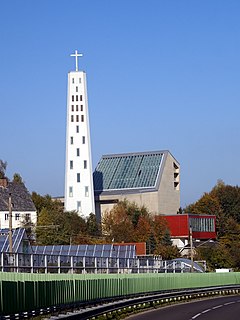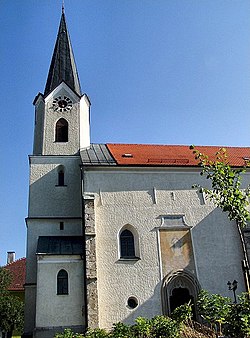
Mauthausen is a small market town in the Austrian state of Upper Austria. It is located at about 20 kilometres east of the city of Linz. The town lies on the banks of the Danube river, opposite the town of Enns, where the major Danube tributary of Enns joins it. During World War II, the town was the site of the Mauthausen concentration camp.

Dachau was the first concentration camp built by Nazi Germany, opening on 22 March 1933. The camp was initially intended to intern Hitler's political opponents which consisted of: communists, social democrats, and other dissidents. It is located on the grounds of an abandoned munitions factory northeast of the medieval town of Dachau, about 16 km (10 mi) northwest of Munich in the state of Bavaria, in southern Germany. After its opening by Heinrich Himmler, its purpose was enlarged to include forced labor, and, eventually, the imprisonment of Jews, Romani, German and Austrian criminals, and, finally, foreign nationals from countries that Germany occupied or invaded. The Dachau camp system grew to include nearly 100 sub-camps, which were mostly work camps or Arbeitskommandos, and were located throughout southern Germany and Austria. The main camp was liberated by U.S. forces on 29 April 1945.

Mauthausen was a Nazi concentration camp on a hill above the market town of Mauthausen, Upper Austria. It was the main camp of a group with nearly 100 further subcamps located throughout Austria and southern Germany. The three Gusen concentration camps in and around the village of St Georgen/Gusen, just a few kilometres from Mauthausen, held a significant proportion of prisoners within the camp complex, at times exceeding the number of prisoners at the Mauthausen main camp.

Ohrdruf was a German forced labor and concentration camp located near Ohrdruf, south of Gotha, in Thuringia, Germany. It was part of the Buchenwald concentration camp network.

Lenzing is a small town of approximately 5,000 residents, three kilometers north of Lake Attersee in Austria, It is located in the Upper Austrian part of the Salzkammergut.

The 71st Infantry Division was a unit of the United States Army in World War II.

Frauenkirchen is an Austrian town in the district of Neusiedl am See, Burgenland.

Lackenbach is an Austrian municipality in the District of Oberpullendorf, Burgenland.

Donnerskirchen is a market town in the district Eisenstadt-Umgebung in the Austrian state of Burgenland.

Ebensee was a subcamp of Mauthausen concentration camp established by the SS to build tunnels for armaments storage near the town of Ebensee, Austria, in 1943. The camp held a total of 27,278 male inmates from 1943 until 1945. Between 8,500 and 11,000 prisoners died in the camp, most from hunger or malnutrition. Political prisoners were most common, and prisoners came from many different countries. Conditions were poor, and along with the lack of food, exposure to cold weather and forced hard labor made survival difficult. American troops of the 80th Infantry Division liberated the camp on 6 May 1945.

Sankt Georgen an der Gusen is a small market town in Upper Austria, Austria, between the municipalities of Luftenberg and Langenstein. As of 2015, the town had 3,779 inhabitants.

Bad Deutsch-Altenburg, until 1928 Deutsch-Altenburg is a market town and spa in the district of Bruck an der Leitha in Lower Austria in Austria.

The Fürstengrube subcamp was organized in the summer of 1943 at the Fürstengrube hard coal mine in the town of Wesoła (Wessolla) near Myslowice (Myslowitz), approximately 30 kilometers (19 mi) from Auschwitz concentration camp. The mine, which IG Farbenindustrie AG acquired in February 1941, was to supply hard coal for the IG Farben factory being built in Auschwitz. Besides the old Fürstengrube mine, called the Altanlage, a new mine (Fürstengrube-Neuanlage) had been designed and construction had begun; it was to provide for greater coal output in the future. Coal production at the new mine was anticipated to start in late 1943, so construction was treated as very urgent; however, that plan proved to be unfeasible.

Père (Father) Jacques de Jésus, O.C.D., was a French Roman Catholic priest and Discalced Carmelite friar. While serving as headmaster of a boarding school run by his Order, he took in several Jewish refugees to protect them from the Nazi government of occupation, for which he was arrested and imprisoned in various Nazi concentration camps.
The Liberators: Fighting on Two Fronts in World War II is a 1992 documentary film co-produced by Bill Miles and Nina Rosenblum and narrated by the actors Louis Gossett Jr. and Denzel Washington. Using interviews, photographs, and diary readings, it tells the story of the primarily black 761st Tank Battalion and 183rd Combat Engineers during World War II, including their experiences of racism in the United States and their involvement in the liberation of Nazi concentration camps. The film was nominated for an Academy Award for Best Documentary Feature.

Gisela Legath from Eberau was a Burgenland woman who saved with the help of her two children Martin Legath and Frieda Legath the life of two Hungarian Jews from the Nazis during World War II by providing a shelter in their barn.

The Holocaust in Hungary was the dispossession, deportation, and murder of more than half of the Hungarian Jews, primarily after the German occupation of Hungary in March 1944.

James Burdette Thayer was an American brigadier general who served on active duty during World War II. On May 4, 1945, Thayer and his platoon discovered and liberated 15,000 people held at a concentration camp near Wels, Austria. Following the war, he continued his service in the United States Army Reserve. In his civilian life, Thayer founded a successful business supply company in Beaverton, Oregon. He was later appointed Oregon's civilian aide to the Secretary of the Army and then re-activated as commander of the Oregon State Defense Force. The Oregon Military Museum at Camp Withycombe is named in his honor.

Gusen was a subcamp of Mauthausen concentration camp operated by the SS between the villages of Sankt Georgen an der Gusen and Langestein in the Reichsgau Ostmark. Primarily populated by Polish prisoners, there were also large numbers of Spanish Republicans, Soviet citizens, and Italians. Initially, prisoners worked in nearby quarries, producing granite which was sold by the SS company DEST.
Edith Eva Eger is a Slovakian-born American psychologist. Born to Hungarian Jewish parents, she is a Holocaust survivor and a specialist in the treatment of post-traumatic stress disorder. Her memoirs entitled The Choice - Embrace the Possible, published in 2017, became an international bestseller. Her second book, titled The Gift - 12 Lessons to Save Your Life was published in September 2020.




















